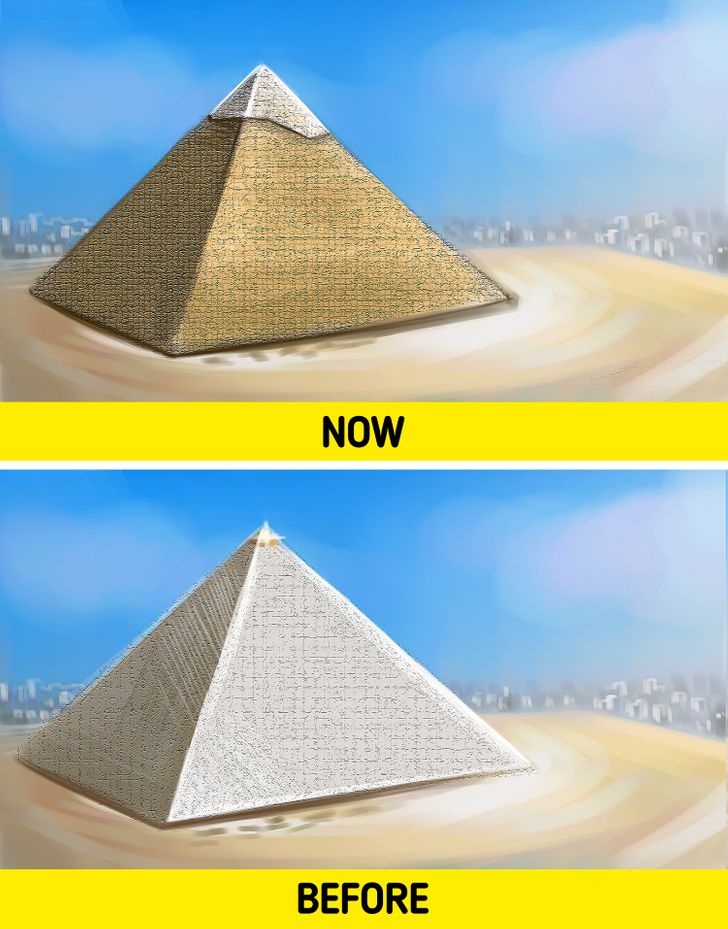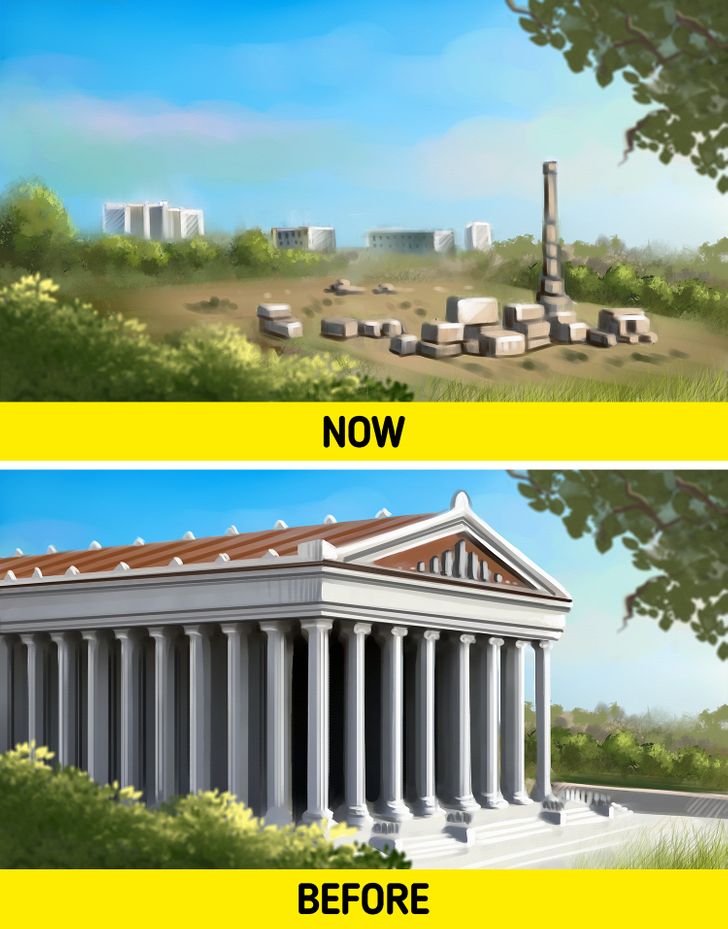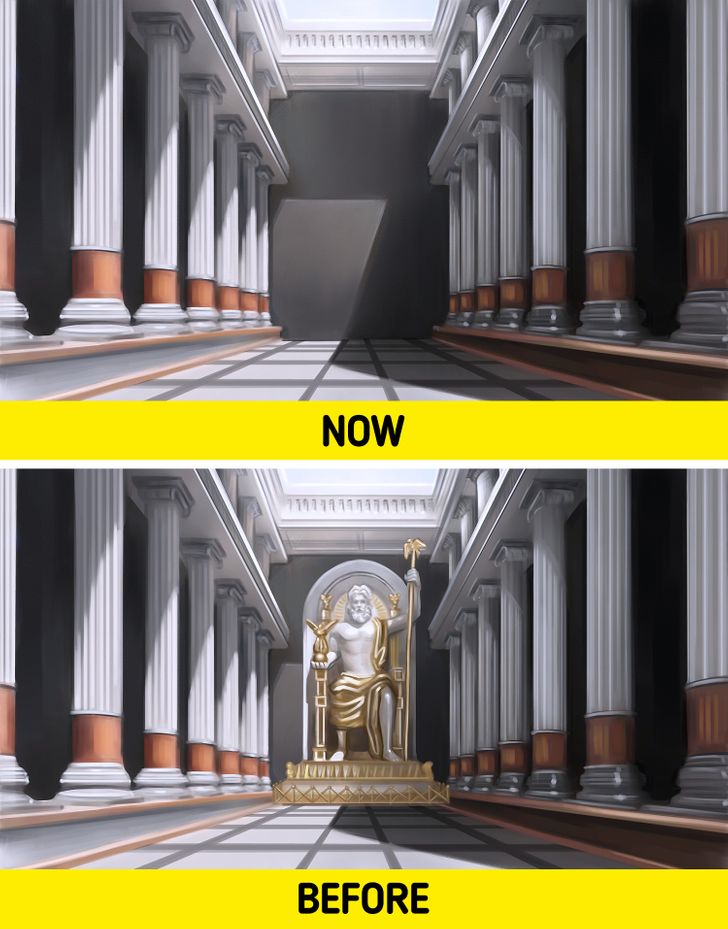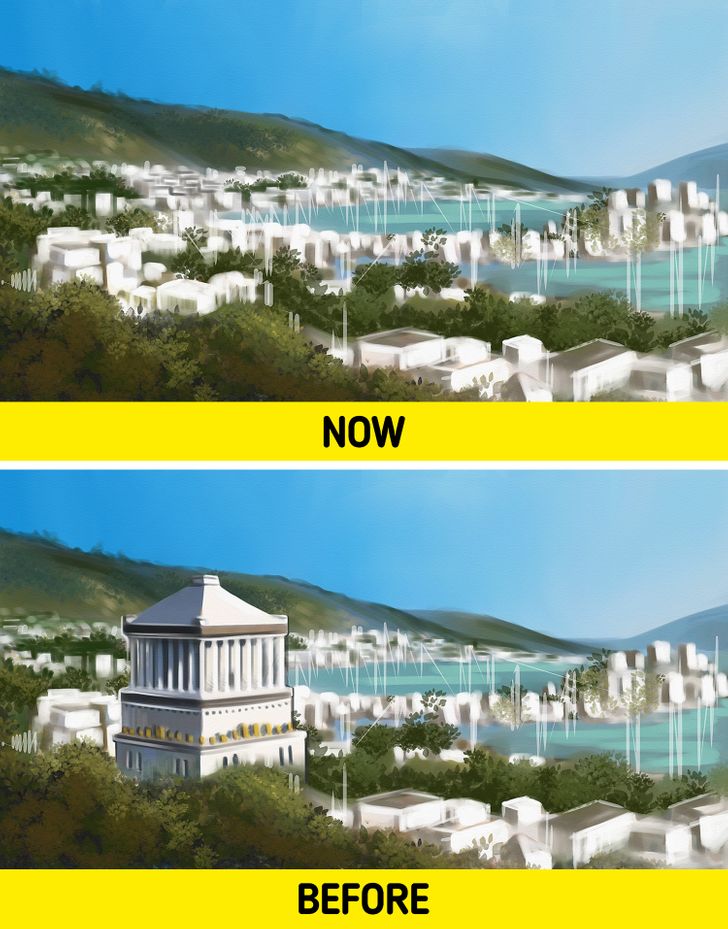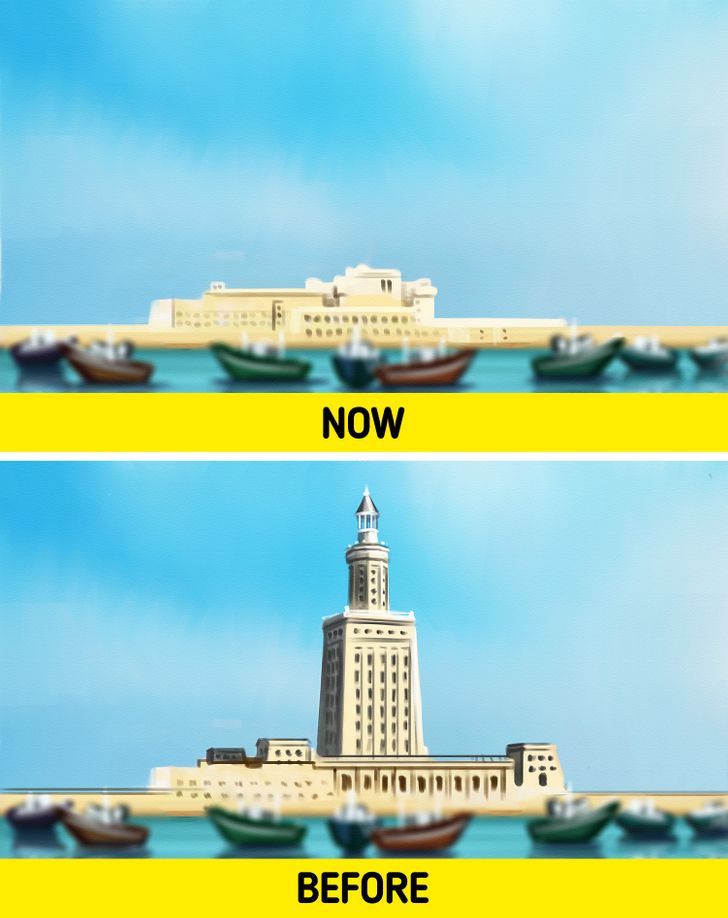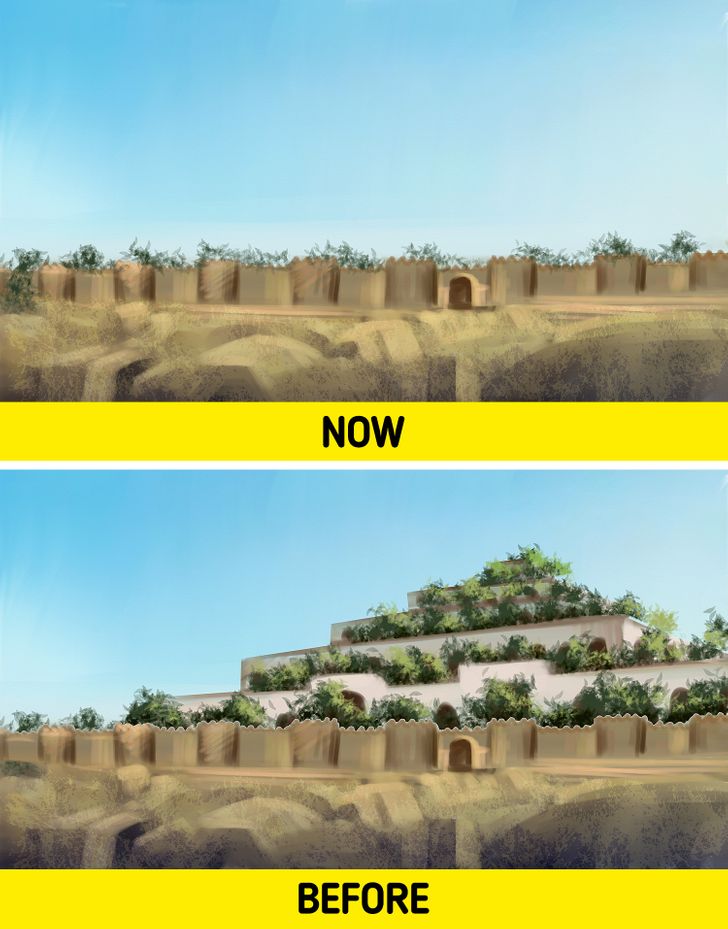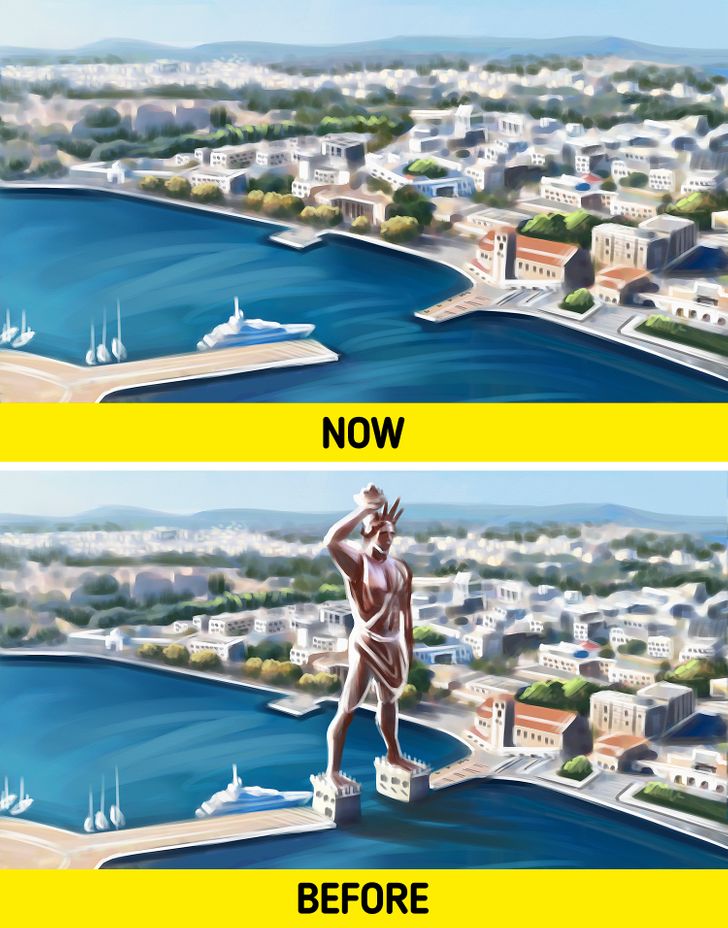What the 7 Wonders of the World Used to Look Like

Each wonder of the world would put the people of those times in awe. And it is all because of the splendor of these structures. Out of all wonders, there is only one that has been fully preserved through today. However, this list also contains a wonder of the world whose location is still unclear and it’s actually still questionable whether it existed at all.
5-Minute Crafts compared how those wonders might’ve looked back then and what is located in their place now. We also learned some impressive facts about each of them.
Great Pyramid of Giza
The Great Pyramid of Giza is the only construction from the list of the ancient Seven Wonders of the World that we can see today. This fact is even more impressive when you realize that the pyramid had been constructed earlier than the other wonders.
It was built over the course of 20 years for the Egyptian pharaoh Cheops. Initially, its height was 479 feet tall and its base was 754 feet wide. More than 2 million stone blocks were used for its construction. Some of them are so huge and heavy that lifting and moving them seems impossible even today.
Though there are many theories regarding the purpose of the Pyramid, the most widespread opinion is that it was the king’s tomb. However, the building process still leaves scientists perplexed. More and more evidence appears that proves ancient Egyptians were using special technical means, which, apparently, were so normal and familiar to them that they simply didn’t need to describe them on paper. Nevertheless, the complexity of inner corridors, the special location of rooms, and the general orientation of the pyramid to the cardinal points attracts speculation about extreme theories such as extraterrestrial help or outside influences.
It’s also worth noting that the popular opinion about using slave labor while constructing the pyramids is actually not true. All constructions were built by employed workers who were paid money for them. Moreover, in 1979, Egyptologists Mark Lehner and Zahi Hawass found workers’ shelters in Giza.
Temple of Artemis at Ephesus
The Temple of Artemis at Ephesus took more than 120 years to be built and was destroyed in one single night. Built in 550 BCE, it was so magnificent that each mention about it was written with special awe. Everyone agreed that it was one of the most amazing structures ever built by people. It measured 425 feet in length and 225 feet wide, with 127 columns as much as 60 feet high.
On July 21st, 356 BCE a person named Herostratus burned the temple to (according to him) get eternal fame for always being associated with the destruction of something wonderful. Alexander the Great was born the same night.
The temple was rebuilt on a smaller scale. According to the historian Strabo, the new version was even better than the original itself. Ephesus started to flourish which attracted unwanted attention from the Goths. During the invasion, they plundered the Temple of Artemis. Rebuilt again, it was finally destroyed by the followers of the Roman emperor Theodosius I, who issued a decree against pagan customs.
The temple of Artemis wasn’t abandoned completely and, in the Middle Ages, its blocks were re-used again while constructing other buildings in Ephesus, which was a normal practice in ancient times. Today all that is preserved from the temple is its foundation and the only column which was built up from the remaining stones. All of these give a sad look to a place that once was one of the most amusing spots in the ancient Mediterranean.
Statue of Zeus at Olympia
This World Wonder was created by the great Greek sculptor Phidias. The statue depicted the God Zeus sitting on his throne. His body was made of ivory, and his clothes were made of hammered gold. It was 40 feet tall and was meant to instill awe in the worshipers visiting the temple.
Not everyone was amused by the giant statue. The historian Strabo wrote that “the greatest of these was the image of Zeus... it was so large that, although the temple was very large, the artist is thought to have missed the proper symmetry, for he showed Zeus seated but almost touching the roof with his head, thus making the impression that if Zeus arose and stood erect he would unroof the temple.”
Nevertheless, Phidias’ masterpiece captivated the ancient world and was a must-see for anyone who attended the ancient Olympics. However, soon the Roman emperor Theodosius I issued a decree to end all cult practices, including the Olympics Games. After that, the temple fell into decay until it was desecrated, and then completely destroyed by earthquakes. Eventually, the ruins were covered with silt brought by the River Alpheus, which gradually changed its course.
The statue didn’t have the same fate as the temple, as they were destined to part and never reunite again. It was repaired several times, the cracks in the ivory were corrected, and supporting columns were possibly added under the throne. The Roman emperor Caligula tried to bring it to Rome but according to the writer Suetonius, the project was abandoned after the giant Zeus mysteriously emitted a roar of laughter and the workers’ scaffolding collapsed. The next indignity was the stealing of its gold parts by Roman Emperor Constantine I.
Finally, the Statue of Zeus was moved to Constantinople in 395 CE where it was destroyed due to an earthquake or tsunami in the 5th or 6th century CE. According to an alternative theory, the statue was destroyed by fire in 475 CE. No matter what the exact reasons for losing this statue were, the surviving descriptions by ancient writers and the images in ancient artworks and on coins are all that have been left from the only “wonder” of the Ancient World that was genuinely worshipped.
Mausoleum at Halicarnassus
The secret of the success of the Mausoleum at Halicarnassus is the bold combination of monumental architecture and a giant sculpture used solely for visual effect, which perpetuates the memory of a mortal, not a god. The construction was built in about 351 BCE and served as a tomb of Mausolus, the ruler of Caria.
The ruler died in 353 BCE and his wife Artemisia decided to create a final resting place worthy of such a great king. She died 2 years after her husband, her ashes were buried with him. Craftsmen continued to work on the structure as a sign of respect for their patroness. As a result, the tomb ended up being 135 feet tall and was richly decorated with magnificent sculptures.
Unlike many other ancient world wonders, the mausoleum remained more or less untouched throughout the entire period of Antiquity despite several earthquakes. Fragments of the surviving structure, including those decorated with sculptures, were used by the Knights of Saint John of Malta in the walls of the castle of St. Peter at Bodrum (the territory of ancient Halicarnassus), constructed c. 1494 CE.
Today the mausoleum looks like several scattered stones and column drums that have nothing that would resemble the once greatest tomb of that world after the Great Pyramids of Giza. Nonetheless, this construction left a big impact on history — it’s because of the ruler Mausolus that we now call tombs mausoleums.
Lighthouse of Alexandria
The Lighthouse of Alexandria greatly influenced the later Arab minaret architecture and undoubtedly was the reason for the appearance of a number of similar structures in harbors throughout the Mediterranean. After the Great Pyramid of Giza, it was one of the tallest constructions in the world built by humans.
The lighthouse was installed on the island of Pharos during the reigns of Ptolemy I and II. It stood 330 feet tall. The structure rose from a large square base to a middle octagonal base to a small circular top. Those who saw the lighthouse in person said that there were no words to describe its beauty.
It stood for more than 1,600 years. Periodically, earthquakes severely damaged the construction but there are notes mentioning regular repair work. Its mention disappears from historical documents after the 14th century CE, presumably due to the fact that the lighthouse was finally destroyed by another earthquake. The tower’s granite foundations were reused in the Qait Bey Fort. Modern archeologists found several stone fragments and 2 monumental figures of Ptolemy I and his queen, Berenice, which may have belonged to the tower and its immediate vicinity.
The word Pharos became the etymological base of the word “lighthouse” in the Greek language as well as many Roman languages like French, Italian, Spanish, Catalan, Romanian, Portuguese, and even Bulgarian. In the French, Turkish, Serbian, and Russian languages, the derivative word means “headlight.”
In 2016, the Egyptian Ministry of State of Antiquities planned to turn the sunken ruins of Ancient Alexandria into an underwater museum, giving tourists access to 2,500 underground stonework dating back to 365 CE.
Hanging Gardens of Babylon
Hanging Gardens of Babylon represented an ascending series of tiered gardens containing a huge variety of trees, shrubs, and grapevines resembling a green mountain.
There are several theories of how this unusual world wonder appeared. According to one of them, the Hanging Gardens were built by the Neo Babylonian king Nebuchadnezzar II for his wife Queen Amytis, because she was missing the green hills and meadows of her motherland Media. Another theory supposes that it’s the creation of the queen Semiramis who presumably rules Babylon in the 9th century BCE.
The Hanging Gardens is the only “wonder” that doesn’t have a definitively established location. There are no Babylonian texts that mention these gardens and no archeological evidence.
Some people stick to the opinion that they were mythical and that all of the writings of Strabo, Diodorus Siculus, and Quintus Curtius Rufus were just a romanticized ideal of an Eastern garden. Other people believe that these gardens were there in Babylon but they were completely destroyed in the 1st century CE. Others believe that the legend refers to the documented garden of the Assyrian King Sennacherib which he built in his capital city of Nineveh on the River Tigris, near the modern city of Mosul.
Colossus of Rhodes
The Colossus of Rhodes was a gigantic bronze statue of the sun god Helios that stood 108 feet tall in the harbor of Rhodes. Created from bronze by the local sculptor Chares, it soon appeared on the list of the must-visit sights among travelers.
Just like many other constructions in Rhodes, Colossus was destroyed by an earthquake. According to the Greek geographist and writer Strabo, the statue snapped at the knees and lay forlorn for centuries by the harbor of Rhodes because local people believed in the prediction of the great oracle of Delphi that said moving the statue would bring bad luck to the city.
Pliny the Elder made the following observations about the frightening image of the fallen colossus, “56 years after this statue was erected it was knocked down by an earthquake — but even as it lies, it excites our wonder and admiration. Few men can clasp the thumb in their arms, and its fingers are larger than most statues.”
According to Theophanes (the Byzantine historian) when Rhodes was occupied, a Jewish merchant from the city of Edessa in upper Mesopotamia bought the bronze wreckage of the Colossus, melted it down, and transported the metal to the East on 900 camels.
